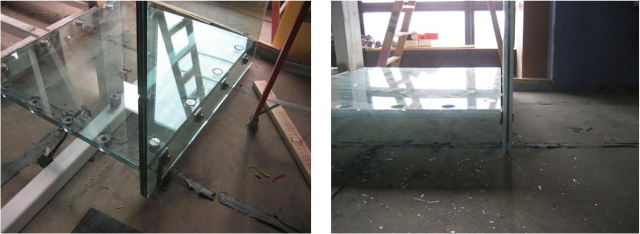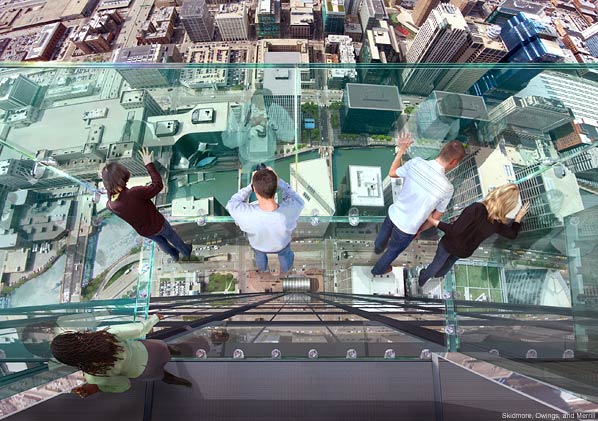Why so much fuss about glass boxes? Well, the image says it all.
The Sears tower (since 2009 sadly renamed as Willis tower) remains the tallest building in the Western hemisphere. Completed in 1973, its 442m (without counting the spires) are still today an impressive height for a building. The Sears tower observation deck, called the Skydeck, is located on the 103rd floor of the tower, and its view 412 m above ground is one of the tourist attractions in Chicago. Visitors, up to now, could experience how the building sways on a windy day. Now they can also feel a different sensation: that of sheer vertigo.
In January 2009 the tower owners began a major renovation of the Skydeck including the installation of four glass balconies, extending approximately 1,2m over the west facade from the 103rd floor. The all-glass boxes allow visitors to look through the floor to the street 412m below. The Ledge opened to the public on July 2009.
The Skydeck renovation project was awarded to Skidmore Owens and Merrill (SOM), the architects who designed the tower. The picture above shows a realistic image of their intention: glass all around, no steel structure at all if possible. “The Sears Tower set architectural and engineering standards when it was first built and now we are able to carefully craft new elements that expand the capabilities of the original design while retaining its integrity,” said Ross Wimer, design partner with SOM and one of the fathers of The Ledge idea. A 360º view of one of the glass boxes (this is not a render) is the nearest you can be to the real sensation of stepping in (or out?) there.
Architects must be praised for the idea, but engineers - glass specialists - were needed for its detailed design and realization. The building owners contracted Halcrow Yolles in Toronto as engineers for the observation boxes, and gave them the responsibility of fully design and detail the glass and steel components. Halcrow's senior principal and structural glass engineer was at the time John Kooymans, one of the few who can say 'The Ledge is my baby'. Around the end of 2009 John moved from Halcrow to another Canadian engineering team, MTE Consultants in Ontario (the name means More Than Engineering). If you visit Halcrow and MTE webpages you will find how both companies claim having authored the engineering design of The Ledge - and both are right!
There are two articles describing the design of the glass boxes both written by John Kooymans, one as part of Halcrow Yolles and the other one written this year as member of MTE. According to the first paper, publised in Glass Performance Days 2009, the challenges to solve were many:
- All glass elements had to be brought up to site using the internal elevators, which limited the size of the box elements.
- The observation boxes had to be moveable. This was required to allow the facade maintenance equipment to operate along the facade without interruptions. But, even more difficult, it was decided that the glass boxes were to be retracted an additional 1200mm into the floor space, so that glass maintenance and cleaning could be done from inside the building.
- There was tenant at the floor below the Skydeck, so all the glass box loads had to be hanged and framed from the ceiling above, in order to avoid interferences.
- Design loads and movements to be imposed onto the glass structure would be very high from the calculation stage. The frame and glass box had to be stiff enough to allow the movement of the box without creating large deformations or stresses at the glass connections.
- The details around the glass box had to include weather seals in both the extended and retracted position, allowing for the movement of the tower, and for the seal to be temporarily broken while the assembly moved from one position to the next.
- The architectural intention was to obtain maximum transparency, including the floor and the roof, minimizing the visible structural steel elements.
- Structural redundancy (safety) and protection of the glass were requested. But, to speed the use of the balconies, visitors would not be forced to protect their shoes when entering. Safety issues excluded the option of double glass, and laminated glass was the solution.
- Outer temperatures should not create a risk of condensation on the glass, or worse allow the formation of ice shards outside the boxes, falling onto the walkway behind. So, the design had to introduce some kind of heating system as well.

The second paper by John Kooymans is the one that originated this post: I read it at the proceedings of Engineering Transparency, a conference held in Glasstec Düsseldorf last 29 and 30 September. Carlos Prada and María Meizoso, two colleagues from Arup Facades Madrid, attended the conferences and brought the news back to us. You can have access to the paper here, through the MTE webpage.
Each box face can withstand design wind pressures of 4.6 kPa, and the roof and floor wind pressures of 6.0 kPa. At the floor there is an additional live load of 4.8 kPa due to its intended occupancy. As Kooymans puts it, it can essentially hold more people than it can fit.
The corners and intermediate joints where the different wall panels come into contact with each other are simply stitched together with stainless steel angles and through bolts. The floor is stitched to the glass walls creating small local opaque connections that allow for the transfer of external loads into the hanging glass panels and subsequently, into the steel cantilevered frame.
From John's Glasstec paper:
The glass had to be designed with enough redundancy to ensure that any accidental breakage would not result in a total collapse of the system. For this reason, three layers of glass were selected for all the elements. The structure was designed so that only two layers of glass were required to resist the design loads, and only one layer of glass would be able to support the self weight of the structure. In addition to this design decision, the glass floor was constructed using an ionoplastic interlayer (SentryGlas Plus) captured by the through bolts in the floor which would ensure the stiffness of the tempered floor panel would remain intact in the remote possibility that all three structural glass lites failed.
In the end, the glass box elements are all created with three layers of 12 mm tempered low iron, heat-soaked glass. The requirement of heat-soaking helped eliminate the potential for spontaneous breakage due to nickel-sulphide inclusions.
If the engineers of The Ledge were Canadians, the facade contractors are pure Chicagoans, and making part of the city building history. MTH Industries, located in Hillside, Illinois, started building glass facades in Chicago back in 1886. Upon first hearing about the project, Ludek Cerny, vice-president of glazing at MTH Industries, thought it was pretty unusual. Because of that, MTH wound up taking on a design-assist role.

Load tests done in-house by the contractor (see images above) involved loading a glass lite that was half the size of the actual floor of the bays to 2½ times the required code load for a 24-hour duration. “The test was later repeated with fracturing one of the lites with the actual design load,” Cerny says. That wasn’t enough for this team: “Out of curiosity,” Cerny says, “we actually broke more lites and realized that you could still stand on the glass floor with all of the lites broken.” Miracles of ionoplastic interlayers.
In addition to avoid damage from breakage, the design includes ways of protecting the bays from daily wear as well. There is an anti-graffiti film on the inside of the vertical glass units. The laminated floor has a 6mm sacrificial layer of fully tempered, heat-soaked glass on top that can be removed or replaced if it gets scratched, cracked or damaged. The stainless steel fasteners that support the glass panes to each other are bespoke and have been custom-machined by MTH.
The motorized system that projects and retracts the boxes from the building utilizes steel LinearBeam mechanical linear actuator systems. The systems operate with a rigid chain technology. A rigid chain is a mechanical actuator that is flexible in one direction and forms a steel beam in the other direction. The contractor worked with the supplier to design the locking pins and the control systems that secure the bays.
Because of the movement, the perimeters of the bays are lined with inflatable seals. When the bay is in the viewing (outside) or in the maintenance (flush) position, the seals inflate to create a secure air and water lock for the building.
Vertical movement - that is, transporting the box material up to the 103rd floor - proved to be one of the bigger challenges for the contractor. The installers moved the glass units and the 5.5m suspension beams up on the top of elevator cars. To ease the material handling, MTH ended up creating custom tools to help hoist and carry. “It was all a conglomeration of things that already existed modified to work under these conditions in the space allowed,” Cerny adds.
The laminated glass units forming the walls and the roof have three tempered 12mm lites of PPG's Starphire low-iron glass. The walls and roof are laminated with clear PVB, while the floors are laminated with 1,52mm DuPont’s SentryGlas Plus interlayers. The glass fabricator was Prelco of Montreal. Prelco delivered its last panel in April 2009, six months after the company began fabrication and two months before the end of the installation on site.
This article from The New York Times has a very interesting short video abour the building of the Ledge. Scroll down and you'll find it on the right. Not to be missed!
The final image is my personal homage to the vision of all the people involved in getting these glass boxes real: from the owner to the architect, engineer, contractor and every supplier. Compare this image with the first render, drawn by the architects in 2008. One year later, the built thing is astonishingly similar to the design intention. In fact, it is even better: by selecting low iron glass, the green aspect of the standard glass used in the first image has disappeared.
Could such a small job have been done better?



























